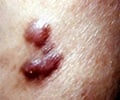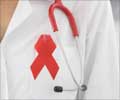He is perhaps the only one believed to have been cured of HIV infection through a bone marrow transplant, and now he wishes to start a foundation to improve research in this area towards a cure.

Since 2007, he has had two high-risk bone marrow transplants and continues to test negative for HIV, stunning researchers and offering new pathways for research into how gene therapy may lead to a more widely acceptable approach.
"I am living proof that there could be a cure for AIDS," Brown told AFP in an interview. "It's very wonderful, being cured of HIV."
Brown looked frail as he spoke to reporters in Washington where the 19th International AIDS Conference, the world's largest meeting of scientific experts, policymakers and advocates is taking place.
The bone marrow transplant he received carried significant risks and may be fatal to one in five patients who undergo it. But he said his only complaint these days is the occasional headache.
He also said he was aware that his condition has generated some controversy, but disputed the claims of some scientists who believe he may still have traces of HIV in his body and may remain infectious to others.
Advertisement
Brown said he fully supports more aggressive efforts toward finding a universal cure, and has met with a number of top scientists in recent days who have treated him "like a rock star."
Advertisement
"There are thousands of very able researchers who cannot get funded for research, so I want to change that. And there are a lot of researchers who are willing to work to find a cure for HIV."
Brown was a student in Berlin, Germany, when he tested positive for HIV in 1995 and was told he probably had about two years to live.
But combination antiretroviral therapy emerged on the global market a year later, and eventually transformed HIV from a death sentence into a manageable condition for millions of people worldwide.
Brown tolerated the medications well but due to persistent fatigue he visited a doctor in 2006 and was diagnosed with leukemia. He underwent chemotherapy, which led to pneumonia and sepsis, nearly killing him.
His doctor, Gero Huetter, had the idea of trying a bone marrow transplant using a donor who had a CCR5 receptor mutation.
People without that receptor appear to be resistant to HIV because they lack the gateway through which the virus can enter the cells. But such people are rare, and are believed to consist of one percent of the northern European population.
It would be an attempt to cure cancer and HIV at the same time.
Brown's leukemia returned in 2007, and he underwent a bone marrow transplant using stem cells from a CCR5 mutation donor, whom he has never met in person. He stopped taking antiretrovirals at the same time.
He soon had no HIV detectable in his system. His leukemia returned though, and he underwent a second bone marrow transplant in 2008, using stem cells from the same donor.
Brown said his recovery from the second operation was more complicated and left him with some neurological problems, but he continues to be free of leukemia and HIV.
Asked if he feels like his cure was a miracle, Brown was hesitant to answer.
"It's hard to say. It depends on your religious belief, if you want to believe it's just medical science or it was a divine intervention," he told AFP. "I would say it's a little bit of both."
Source-AFP














